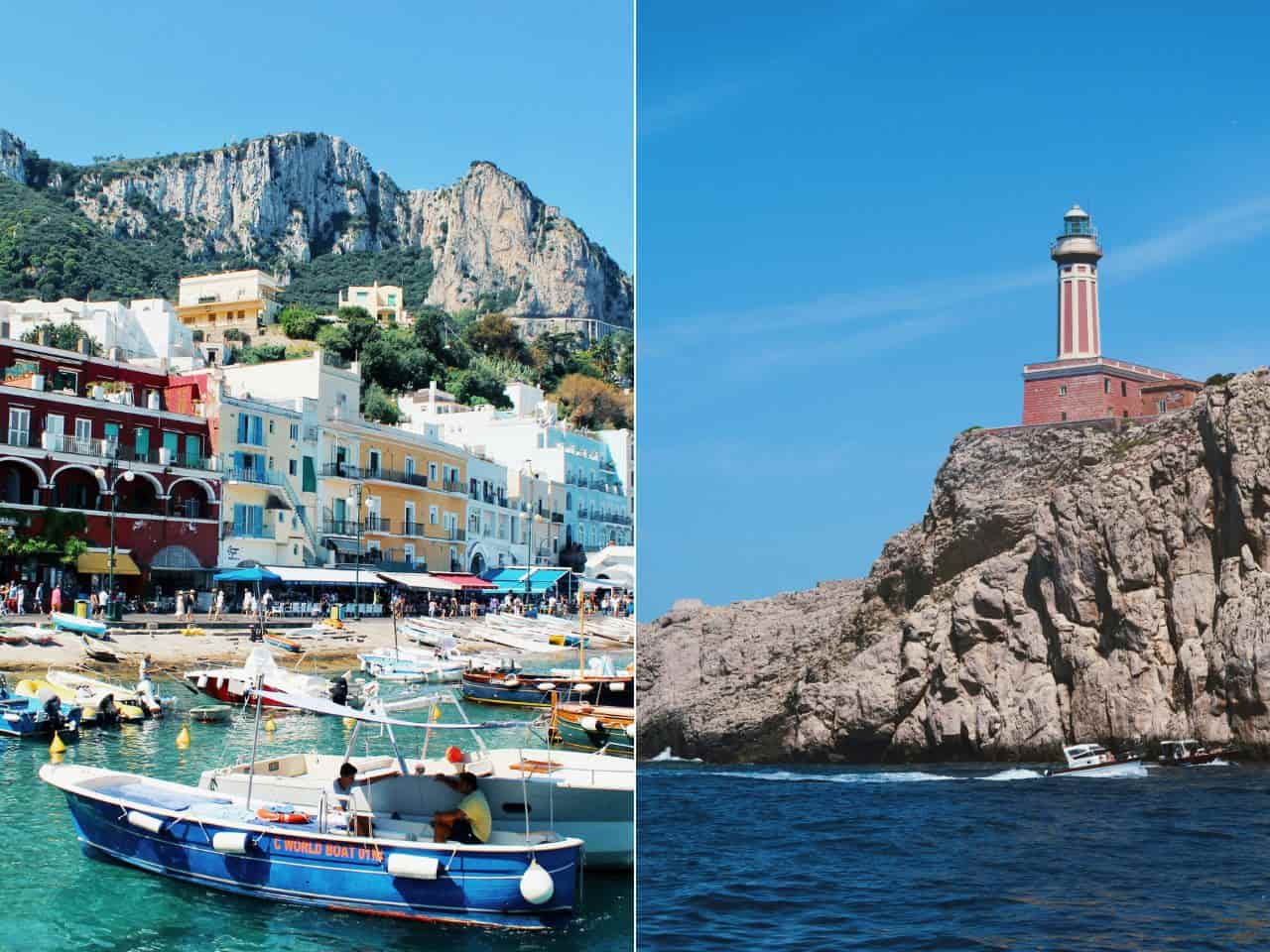Dreaming of exploring the enchanting Capri Island?
This dreamy Italian gem feels like stepping into a postcard—think jaw-dropping blue waters, chic vibes, and those iconic Faraglioni rocks.
Oh, and let’s not forget the magical Blue Grotto; it’s like nature’s neon-lit secret cave.
Let me guide you to uncover all the best things to do in Capri, where every corner feels like a movie set!
Love this? don’t forget to bookmark your Best Time To Visit Italy Along with 29 Essential Italy Travel Tips to make most of your Italian adventure!
What is Capri, Italy best known for?
Located in southern Italy, Capri sits right in the heart of the stunning Bay of Naples.
This small, magical island is tucked just off the Sorrentine Peninsula, only a short boat ride from Naples, Sorrento, and the Amalfi Coast — which, by the way, was declared a UNESCO World Heritage Site in 1997.
Though Capri covers just about 10 square kilometers (around 4 square miles), every inch bursts with beauty. The island is split into two parts: Capri Town, the lively hub filled with boutique shops and cafés, and Anacapri, a quieter, more scenic spot perched up in the hills.
Capri is world-famous for its breathtaking coastal views, luxurious atmosphere, and iconic landmarks like the Blue Grotto, the Faraglioni rocks, and the glamorous Piazzetta.
It’s a dreamy island where turquoise waters meet designer boutiques, lemon-scented lanes, and cliffside walks — a perfect blend of natural wonder and timeless Italian charm.
Capri truly is Italy’s crown jewel in the Tyrrhenian Sea, part of the Campania region. Whether you’re chasing a touch of glam or pure serenity, this little island will steal your heart in no time.
25 Epic Things To Do In Capri (You’ll Never Forget!)
1. Explore The Blue Grotto
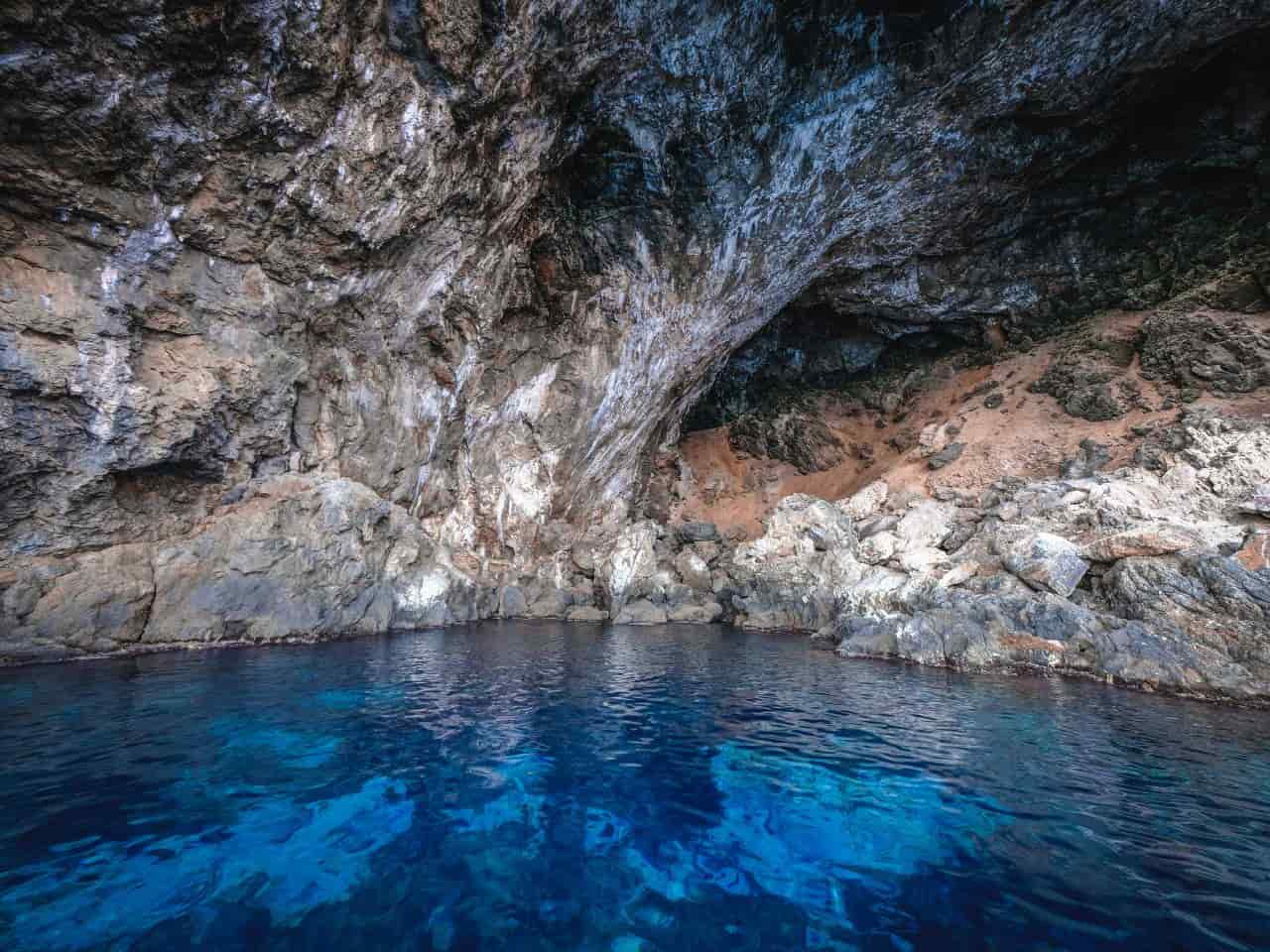
Visiting the Blue Grotto (Grotta Azzurra) is hands down one of the most magical experiences you can have on Capri Island, and there’s a good reason why it tops almost every must-do list!
It isn’t just any sea cave—it’s a natural wonder with a dramatic mix of nature and history. The cave is famous for its unique lighting effect. When sunlight streams through an underwater opening, it refracts through the water and creates a surreal electric blue glow inside the grotto. It’s mesmerizing, almost as if the water is lit from below.
Now, here’s where history comes into play. Back in Roman times, the grotto was believed to be magical or sacred place. In fact, Emperor Tiberius, who lived on Capri, is said to have used the Blue Grotto as his private swimming pool!
Roman statues have even been discovered inside, adding a fascinating archaeological twist to your visit. Imagine floating in the same waters as ancient emperors—how cool is that?
Reaching the Blue Grotto is a little adventure in itself, but trust me, it’s worth every effort:
- Boat Tours: The most popular way is to take a boat tour from Marina Grande, the main port of Capri. These tours usually include a stop at the Blue Grotto, giving you a chance to hop into smaller rowboats that take you inside.
- By Land: If you’re up for some walking, you can take a bus or taxi to Anacapri and then head down to the grotto’s entrance. From there, you’ll board a rowboat for the final stretch.
From the entrance, you’ll switch to a tiny rowboat (only small boats can fit through the opening). The rowers themselves are part of the charm—they often sing traditional Neapolitan songs, adding to the atmosphere.
Once you’re in that tiny rowboat, your guide will carefully navigate the low, narrow entrance. Be prepared to duck! As soon as you pass through, you’ll be met with the breathtaking glow of the water—it’s an experience you’ll never forget.
The cavern is about 60 meters long and 25 meters wide, with a ceiling that towers 14 meters above. It’s big enough to feel awe-inspiring but small enough to feel intimate.
Your time inside the grotto is usually short, around 5–10 minutes, but it’s enough to soak in the beauty and snap a few unforgettable photos.
It is open daily from 9:00 AM to 5:00 PM, but only when the sea conditions are calm. If the tide is too high or the waves are choppy, the grotto is closed for safety reasons.
Things to Keep in Mind
- Entry Fee: €14 per person to access the grotto, plus a tip for the rower (typically €5–€10).
- Boat Tour Costs: Tours from Marina Grande usually cost around €20–€25, excluding the grotto entry fee.
- Crowds: The Blue Grotto is incredibly popular, so be prepared for a wait during peak hours. But arriving early can surely help you beat the rush.
2. Ride the Monte Solaro Chairlift
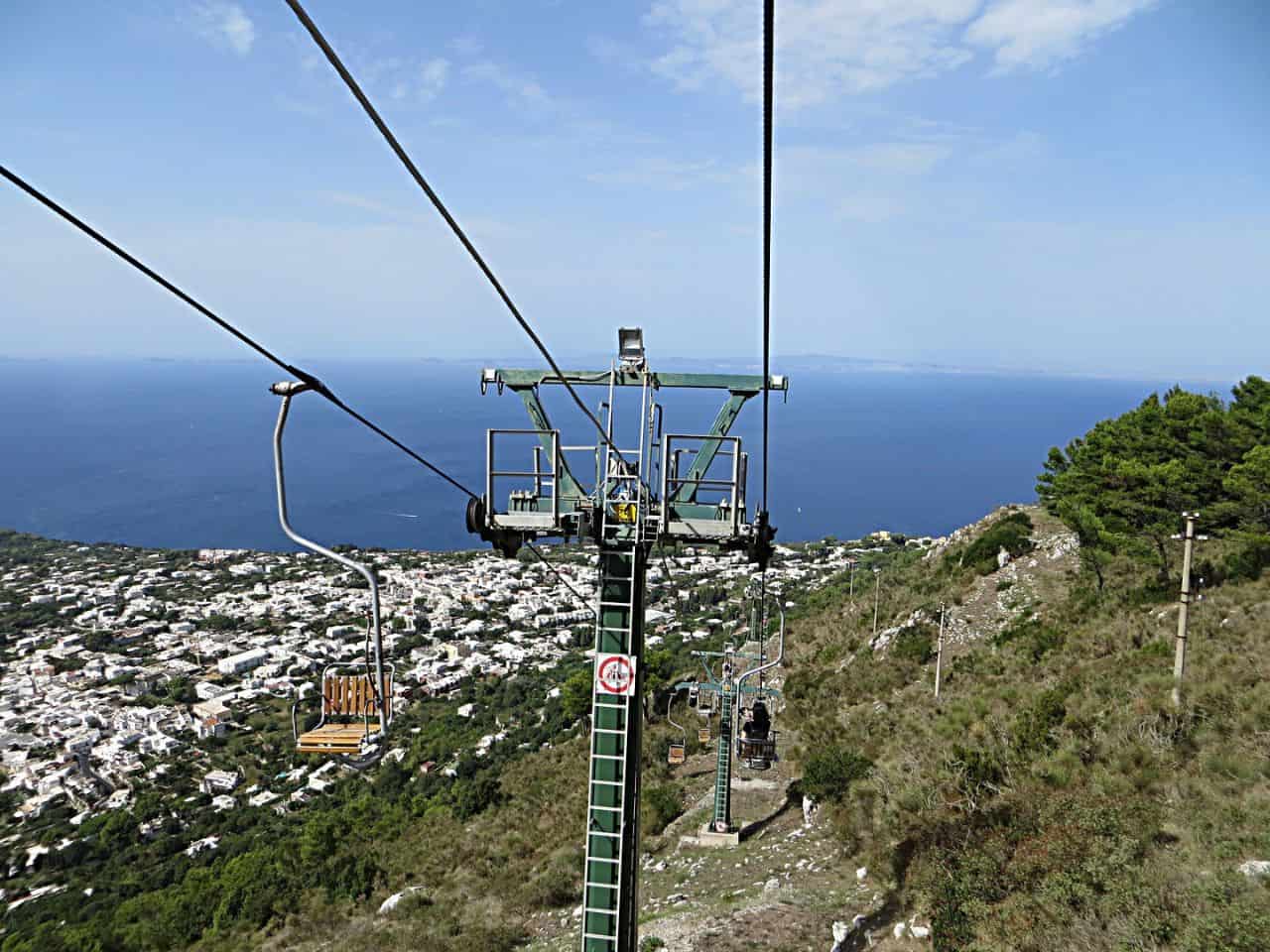
Monte Solaro is the highest point on Capri, standing at an impressive 589 meters above sea level. The chairlift gives you a front-row seat to views that are nothing short of spectacular.
Trust me, riding it in Capri is one of those unique things to do which will give you an unforgettable experience that combines adventure, stunning views, and a dash of history.
As you ascend, the sparkling Mediterranean stretches endlessly before you, the Amalfi Coastline glistens in the distance, and Capri’s lush greenery hugs the cliffs below.
Historically, this peak was used for military purposes, as it provided an incredible vantage point over the Bay of Naples and surrounding areas.
Today, the chairlift represents a modern way to connect with this historic site, offering effortless access while maintaining the area’s natural beauty.
The chairlift operates daily from 9:30 AM to 5:00 PM, with extended hours in the summer months.
The chairlift is a single-seat system that takes you from Anacapri to the summit of Monte Solaro in about 13 minutes. It’s an open-air ride, which means you’ll be dangling gently above olive groves, wildflowers, and charming villas.
The pace is slow enough to let you savor the views but quick enough to make it an efficient way to explore.
Once you reach the summit, you’ll be greeted by panoramic views that will take your breath away. On a clear day, you can see as far as Naples, Mount Vesuvius, the Sorrentine Peninsula, and the Amalfi Coast.
There’s also a small café where you can enjoy a coffee or gelato while soaking in the views. If you’re interested in history, the ruins of Fortino di Bruto, a fort from the Napoleonic wars, are just a short walk away and worth exploring.
If you’re up for it, you can take the chairlift one way and hike the other, giving you the best of both worlds.
Things to Keep in Mind
- Round-trip: €12
- One-way: €9
- Not Ideal for Acrophobics: The open-air design can feel intimidating if you’re afraid of heights, though the ride is incredibly safe.
3. Walk through Gardens of Augustus
The Gardens of Augustus is originally known as the Krupp Gardens, dating back to the early 20th century. They were commissioned by Friedrich Alfred Krupp, a wealthy German industrialist, who fell in love with Capri and made it his summer retreat.
Krupp also financed the construction of the nearby Via Krupp, which connects the gardens to Marina Piccola below.
Over the years, the gardens have been lovingly preserved and renamed to honor Emperor Augustus, who was known to visit Capri and contributed to its rich Roman history. Today, they stand as a testament to the island’s timeless allure and its ability to captivate visitors from all walks of life.
The gardens are relatively small, but their well-manicured paths and vibrant flowers make them a delight to explore. You’ll find everything from exotic plants to local flora, creating a colorful and fragrant escape from Capri’s bustling piazzas.
It offers some of the best panoramic views on the island. From its terraces, you can marvel at the iconic Faraglioni sea stacks rising dramatically out of the turquoise waters. On the opposite side, the winding Via Krupp—a historic pathway carved into the cliffs—adds an extra dose of charm to the scene.
Things to Keep in Mind
- Timings: These gardens are typically open daily from 9:00 AM to 7:00 PM, with reduced hours in the off-season (usually closing at 4:00 PM).
- Entry Fee: A small fee of around €1 is charged, making it one of the most affordable attractions on the island.
- Seasonal Blooms: Spring and summer are the best times to see the gardens at their most vibrant.
- Bring Water: Capri can get hot, and while the gardens are shady, you’ll appreciate staying hydrated.
4. Admire the Faraglioni Rocks Formations
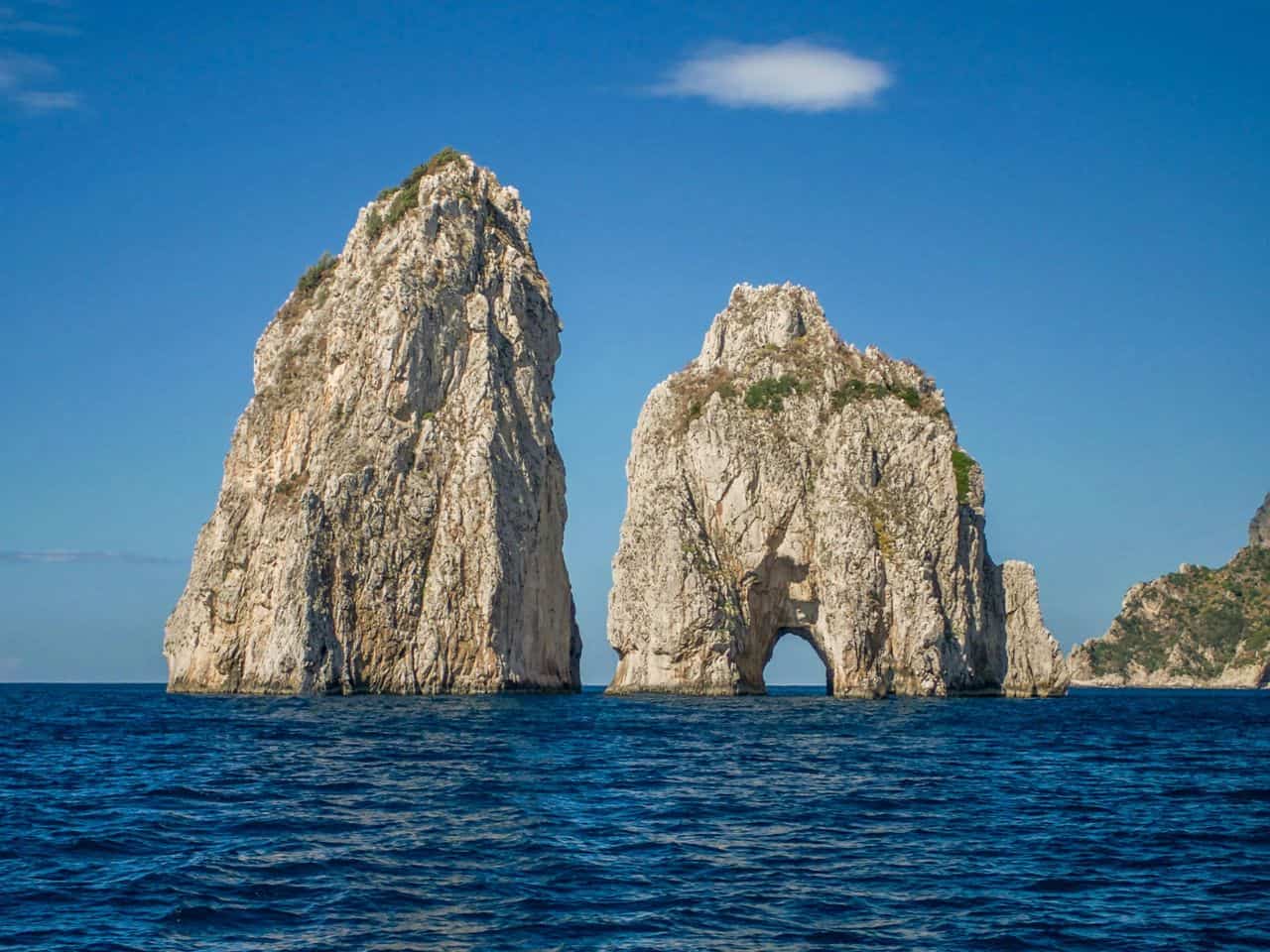
No list of best things to do in Capri is complete without exploring the Faraglioni Rocks. These towering limestone formations rise majestically out of the crystal-clear waters of the Mediterranean, creating one of the most iconic and breathtaking sights in all of Italy.
They have been celebrated for centuries. In ancient Roman times, they were considered sacred and associated with the sea gods.
The Faraglioni Rocks aren’t just natural formations; they’re symbols of Capri. Each of the three main rocks even has its own name and unique character:
- Stella, the closest to the island.
- Faraglione di Mezzo, the middle rock with a famous natural arch you can sail through.
- Faraglione di Fuori, the farthest rock, also known as Scopolo, which is home to the rare and unique blue lizard found only in Capri.
These rocks have been shaped over millennia by wind and waves, standing as eternal sentinels of Capri’s beauty. For couples, they’re a particularly romantic spot, as legend says sailing through the arch of Faraglione di Mezzo while sharing a kiss will ensure everlasting love.
Interestingly, the unique blue lizard found on Scopolo adds an extra layer of intrigue. This rare species has adapted to its isolated environment, becoming a symbol of Capri’s distinct and precious biodiversity.
There are different ways to admire these rocks but the best way to experience it is by taking a boat tour. Whether you hop on a guided tour or rent a private boat, sailing around these magnificent structures gives you an up-close view of their grandeur.
And let me tell you this, the thrill of passing through the arch of Faraglione di Mezzo is just unforgettable!
If you prefer to admire the rocks from land, the Gardens of Augustus offer a spectacular vantage point. Another fantastic viewpoint is from Punta Tragara, a scenic overlook that provides a postcard-perfect perspective of the Faraglioni.
For a relaxing experience, head to Marina Piccola, where you can sunbathe on the beach with the Faraglioni Rocks as your backdrop.
Things to Keep in Mind
- Boat Tours: Guided boat tours around the Faraglioni typically run from early morning (8:00 AM) to sunset, depending on the season. Prices start at around €20-€25 per person for group tours, while private boat rentals can range from €150-€500, depending on the duration and type of boat.
- Sunset Views: Visiting during sunset adds a magical golden hue to the rocks and makes for stunning photos.
5. Stroll in Capri Town
Capri Town, or Piazzetta di Capri, is often referred to as the “living room of the world” for a reason. This lively square is the heartbeat of the island, where locals and tourists come together to enjoy the vibrant atmosphere. From sipping espresso at an outdoor café to shopping for handmade sandals or luxurious designer pieces, the town offers something for everyone.
But it’s not just about shopping or dining; Capri Town is a place to soak in the island’s elegance and history. Every corner seems to whisper stories of the island’s glamorous past, when Roman emperors, writers, and Hollywood celebrities frequented this jewel in the Mediterranean.
The island was a favorite retreat of Emperor Tiberius, who ruled from his villa here. Over centuries, it has evolved into a haven for artists, writers, and even for some renowned celebrities. The glamour of Capri Town is deeply rooted in its past, and as you wander its streets, you’ll feel like you’re walking through living history.
Start your journey by visiting the beating heart of Capri Town, La Piazzetta which is a lively square surrounded by cafés, restaurants, and historical landmarks. It’s the perfect spot to relax, people-watch, and sip on a refreshing limoncello.
Don’t rush here—soak up the island’s lively yet laid-back vibe!
The real charm of Capri Town lies in its winding alleyways. These streets are full of surprises, from artisan shops to charming flower-laden balconies. You’ll also find exclusive boutiques featuring high-end fashion brands like Gucci and Prada, perfect for those seeking a touch of luxury.
Things to Keep in Mind
- Best Time to Visit: Capri Town is best explored in the early morning or late afternoon to avoid crowds, especially during the peak summer season. Spring and autumn are ideal for pleasant weather and a more relaxed atmosphere.
6. Visit Certosa di San Giacomo
When exploring Capri, a visit to this serene monastery is like stepping into a time machine that takes you back to the 14th century. It was built in 1371 by Count Giacomo Arcucci, under the rule of Queen Joanna I of Anjou.
The purpose of building this famous landmark of Capri is to offer a haven for Carthusian monks who lived a life of silence and prayer. Over the centuries, it has witnessed invasions, restorations, and even repurposing as a prison and military barracks.
Despite the upheavals, the monastery has retained its unique charm, blending its Gothic, Baroque, and Renaissance elements into a harmonious architectural masterpiece.
It is an exquisite example of medieval design with a mix of simplicity and grandeur. Its cloisters—one grand and one smaller—are peaceful spots that exude calm.
Within its walls, the monastery houses a museum dedicated to Karl Wilhelm Diefenbach, a 19th-century German painter who lived on Capri. His mystical and nature-inspired works are a must-see for art enthusiasts.
Things to Keep in Mind
- Opening Hours: It is typically open from 9:00 AM to 2:00 PM, but timings can vary depending on the season or special events.
- Entry Fee: Expect to pay a modest fee of around €6-€8 for entry. Children and EU students often enjoy discounted rates, so carry your ID.
7. Wander through Anacapri Attractions
Unlike Capri town, which often buzzes with high-end boutiques and crowds, Anacapri has a laid-back vibe that invites you to slow down and soak in its timeless beauty. Nestled on the slopes of Mount Solaro, this picturesque town offers a refreshing escape from the bustling main areas of Capri.
Anacapri has a history that dates back to Roman times, and its name reflects its location—“Ana” means “above,” indicating its position above Capri town. The area was a favorite retreat for emperors, writers, and artists seeking inspiration.
It is also home to some of Capri’s most iconic attractions, offering a rich blend of history, panoramic views, and unique experiences. If you’re a history buff, a nature lover, or someone who simply enjoys getting lost in charming streets, Anacapri has something special for you.
Getting there is simple, take a bus or taxi from Capri town or Marina Grande. The bus ride is about 10 minutes and offers scenic views along the way.
Once you’re there, visit villa San Michele, one of Anacapri’s most treasured landmarks, is a historic villa built by Swedish physician and author Axel Munthe. The villa is a masterpiece, with a mix of Roman, medieval, and Renaissance architectural elements.
As you stroll through its gardens, you’ll be rewarded with stunning views of Capri, the Gulf of Naples, and Mount Vesuvius. It opens daily from 9:00 AM to 6:00 PM (hours may vary seasonally) with entry fees around €10.
Next head to the Church of San Michele, a charming 18th-century church to admire its stunning majolica floor depicting the Garden of Eden. It’s a hidden gem that showcases incredible artistry and provides a peaceful spot for reflection.
It typically opens from 9:00 AM to 7:00 PM, charging entry costs around €2-€3.
Things to Keep in Mind
- Best Time to Visit: Spring (April to June) and early autumn (September to October) are ideal for exploring, with pleasant weather and fewer crowds.
8. Visit the Capri Philosophical Park
If you’re looking for a quieter, more contemplative experience on Capri, away from the bustling Piazzetta and busy beaches, visiting this hidden gem is your ideal retreat!
Situated on the rugged cliffs of Anacapri, the park was founded in 2000 by Gunnar Adler-Karlsson, a Swedish professor of political philosophy, and his wife Marianne. They envisioned a space where visitors could ponder life’s most profound questions while surrounded by the natural beauty of Capri.
The park is completely free to visit – Yes, you read that right, it is one of those free things to do in Capri that will feed your mind without a cost of a cent.
The location itself is stunning, tucked away in the Damecuta area, one of the less-traveled parts of the island. What sets this park apart is its unique concept. Throughout the park, you’ll find philosophical quotes from great thinkers such as Socrates, Confucius, and Nietzsche engraved on ceramic tiles.
These quotes are strategically placed along the trails, encouraging visitors to pause and reflect as they walk. Each tile is a small invitation to think about happiness, love, freedom, and the human condition.
Things to Keep in Mind
- Location: It’s best accessed by foot from Anacapri’s town center.
- Timings: The park is open year-round only during daylight hours. Early morning or late afternoon is the best time to visit to avoid the midday heat.
WANT TO EXPLORE MORE?
Sign up for my newsletter and I will email you every time I have something new to say!
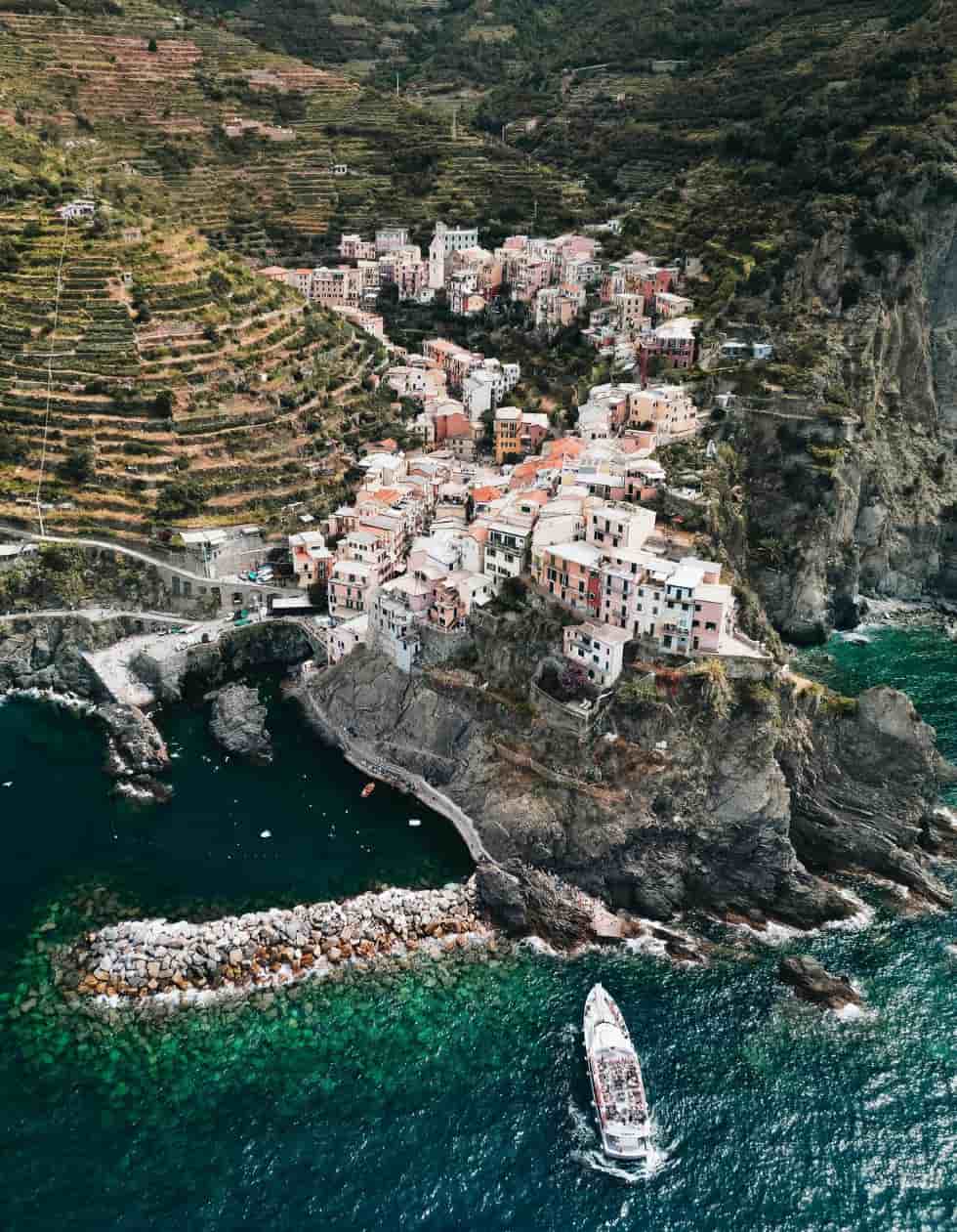
9. Feel the Church of San Michele
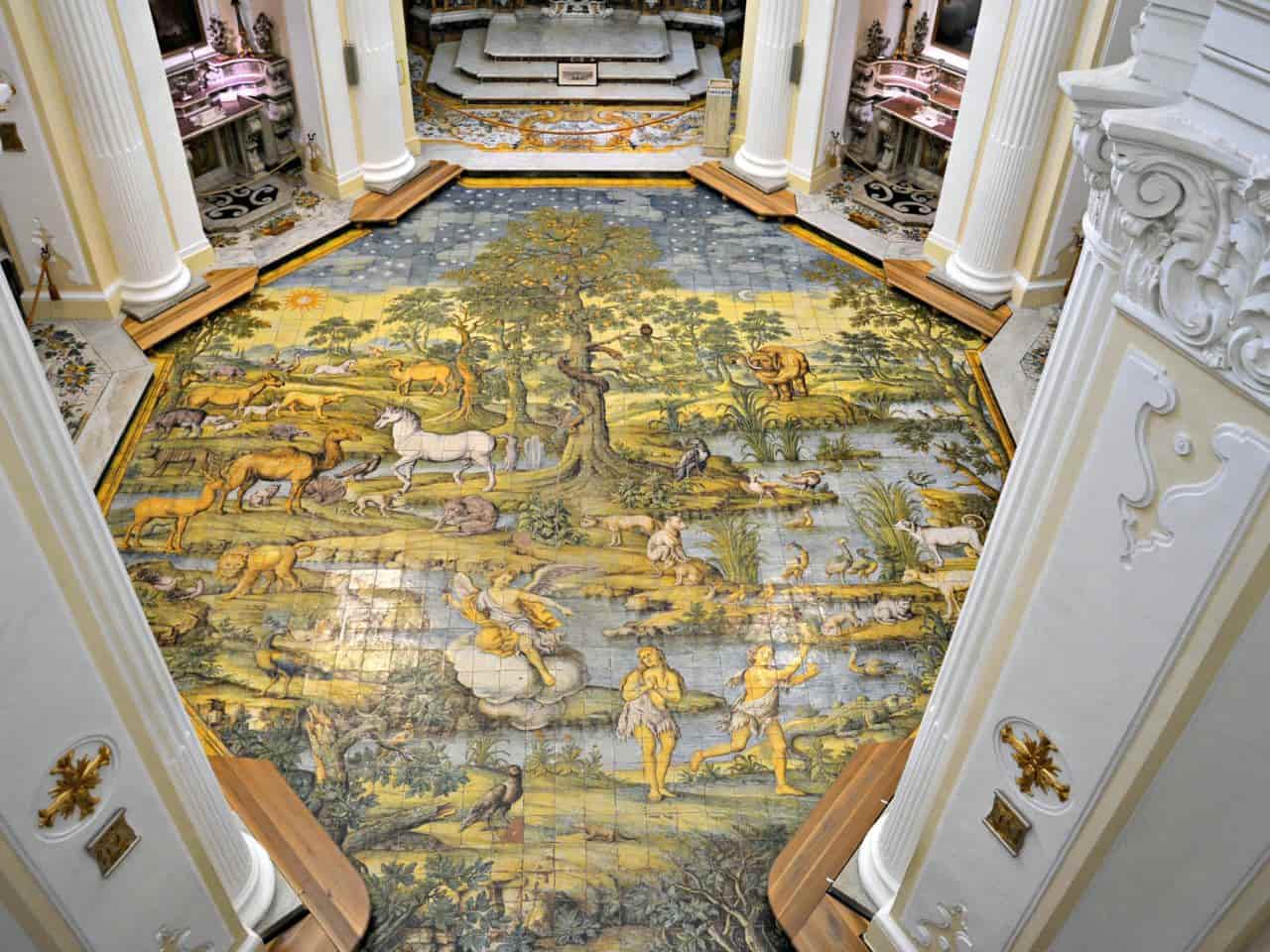
You may wonder why visiting a church is in this list of best things to do on Capri? Then let me tell you that it’s like walking on a work of art!
Yes, you read that right.
The Church of San Michele is a Baroque masterpiece that stands out for its extraordinary floor—a mosaic made entirely of hand-painted majolica tiles.
What makes it even more remarkable is the story these tiles tell: they depict the Garden of Eden, complete with Adam, Eve, the serpent, and a myriad of animals.
You’re gazing down and seeing lions, peacocks, elephants, and mythical creatures all intricately detailed on the floor beneath your feet!
But it’s not just the floor that makes this church a must-visit. The architecture, with its octagonal shape and elegant altar, showcases Baroque design at its finest.
This stunning church was built in the early 18th century, between 1698 and 1719, under the guidance of Father Francesco Antonio Maggio. The majolica floor was crafted by Neapolitan artist Leonardo Chiaiese, whose work captures both biblical themes and the natural world in vivid, colorful detail.
Hence over the centuries, the church has remained a symbol of Anacapri’s cultural and spiritual identity where every corner exudes a sense of history and devotion, making it a feast for both the eyes and the soul.
Things to Keep in Mind
- Opening Hours: The church is typically open daily from 9:00 AM to 7:00 PM, but hours may vary during off-season months, so it’s a good idea to check locally.
- Entry Fee: The small admission fee (around €2-3) is well worth it for the experience. It’s also a way to help preserve this historical gem.
10. Discover the Phoenician Steps
If you’re adventurous, challenge yourself with a hike up the ancient Phoenician Steps, a steep staircase connecting Capri town to Anacapri.
Despite their name, these steps weren’t actually built by the Phoenicians but by the ancient Greek settlers who colonized Capri. For centuries, they served as the only pathway connecting Anacapri to the rest of the island, long before modern roads were constructed.
With over 921 steep steps carved into the cliffside, climbing these steps also called Scala Fenicia is a workout that rewards you with spectacular views of the Mediterranean Sea and Capri’s rugged coastline.
During the Roman Empire, the Scala Fenicia became an important link for trade and communication. The steps played a vital role in daily life, as goods, animals, and people traveled this steep route.
These steps begin at Marina Grande, near the main harbor of Capri. They wind up to Anacapri, with a total elevation gain of about 300 meters.
Depending on your fitness level, it can take anywhere from 30 to 60 minutes to climb. Notably, the trail becomes especially beautiful in spring when wildflowers bloom.
As you ascend, the meticulous stonework reflects the architectural expertise of ancient builders, and you’ll feel like you’re retracing the footsteps of those who lived on this island thousands of years ago.
11. Enjoy at Marina Grande
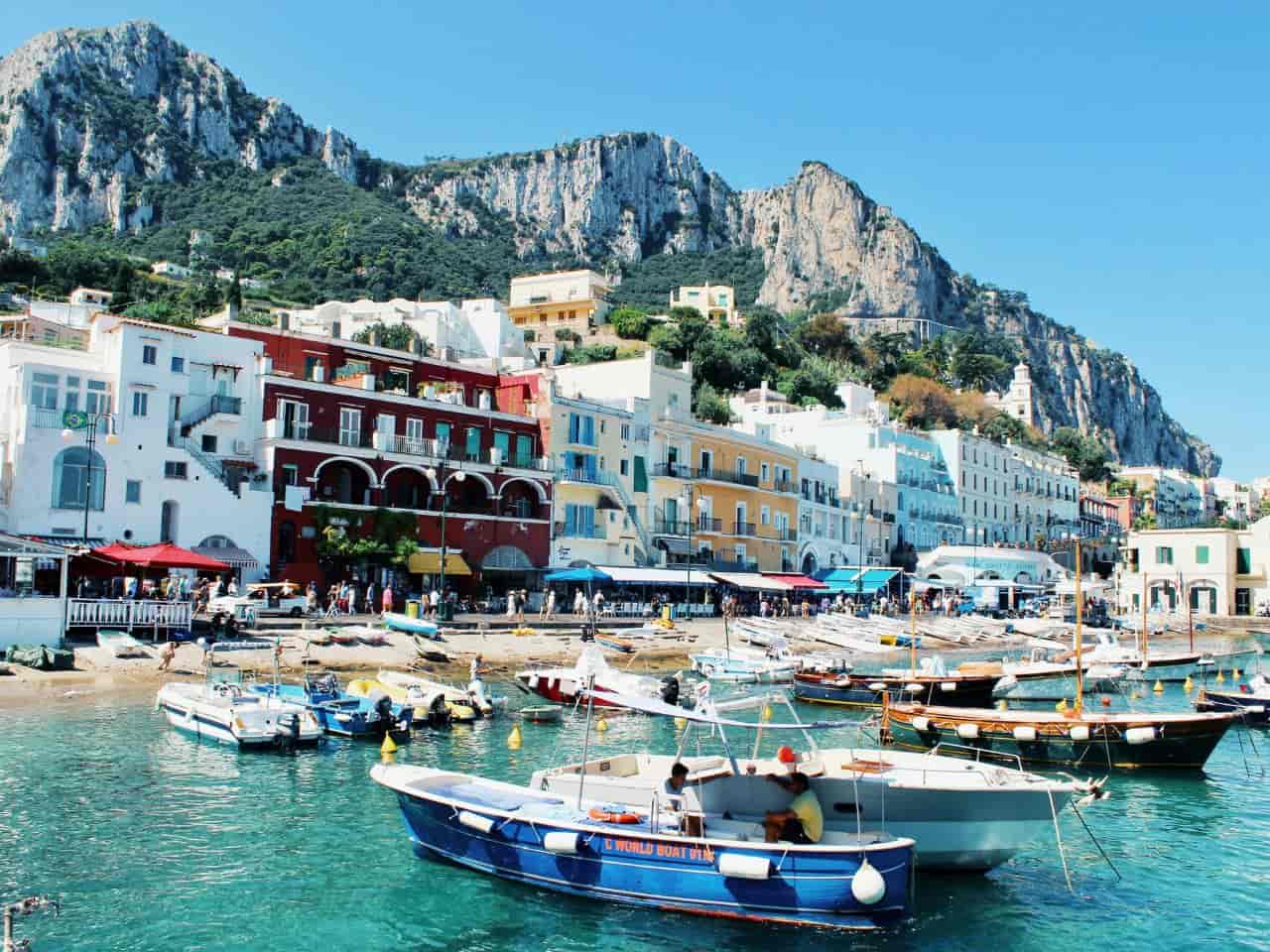
One of the most delightful things you can do when visiting Capri Island is to spend some quality time at the Marina Grade. This picturesque port area is more than just a transit point; it’s a vibrant hub where the charm of Capri truly comes alive.
It’s actually the very first place you’ll encounter when you arrive on Capri, and it sets the tone for the island’s relaxed yet glamorous atmosphere.
Historically, it was once a bustling Roman harbor and has evolved over centuries into a modern yet quaint port. Many of the colorful houses and buildings you see here date back to the 18th and 19th centuries, reflecting a mix of traditional and Mediterranean architectural styles.
If you’re craving a bit of sun and sea, head to the beach at Marina Grande. It’s one of the largest beaches on the island, offering a mix of pebbly and sandy areas.
Not only that but the turquoise waters here are calm and ideal for swimming, making it a great spot for families or anyone looking to unwind by the shore.
Thin place is a home to several waterfront restaurants and cafés that serve up fresh seafood and local specialties.
Moreover, the marina area has plenty of small shops and boutiques where you can pick up souvenirs, handmade goods, or even local limoncello. It’s the perfect place to bring home a little piece of Capri.
Also it is the starting point for many boat tours around the island, including trips to the famous Blue Grotto or around the Faraglioni Rocks.
So, whether you’re soaking up the coastal vibes, indulging in delicious seafood, or simply people-watching against the backdrop of colorful buildings and sparkling waters, Marina Grande is the perfect spot to start or end your Capri adventure.
Things to Keep in Mind
- Boat Tours: Prices vary depending on the type of boat and duration, starting from €20 for group tours and upwards for private charters.
- Beach Facilities: Public access is free, but renting sunbeds or umbrellas costs around €10–€20.
12. Hike the Path of Forts
If you’re looking to experience the rugged charm of this island away from the usual tourist hotspots, then it’s one of the few incredible things to do on Capri that doesn’t come with a hefty price tag.
The Path of Forts, or Sentiero dei Fortini, takes you along Capri’s western coastline, showcasing the island’s natural beauty and its fascinating past. The trail links three ancient forts—Forte di Orrico, Forte di Mesola, and Forte di Pino—that once served as strategic military outposts.
These forts along the trail were constructed by the British during the early 19th century as part of their defense strategy. When Capri was later occupied by the French, these forts were repurposed for their military needs.
This is open year-round, and there’s no entrance fee to access the trail making it a budget-friendly activity on an otherwise luxurious island.
It starts from near the Blue Grotto and stretches toward Punta Carena Lighthouse. The entire trail is about 3.5 kilometers (2.2 miles) long and takes approximately 2–3 hours to complete, depending on your pace and how often you stop to admire the views.
And if you’re starting from the Blue Grotto, you’ll need to pay the usual entrance fee of €14 if you want to visit the grotto before beginning your hike. However, visiting the grotto is optional.
I would highly suggest early morning or late afternoon as ideal for hiking to avoid the midday heat, especially in summer. On the other hand spring and autumn offer cooler temperatures and vibrant natural scenery.
Things to Keep in Mind
- Difficulty Level: The entire trail is considered moderate. While most of it is well-marked and manageable, there are some uneven sections, so make sure to wear sturdy footwear.
- What to Bring: Don’t forget water, sunscreen, a hat, and a camera to capture the stunning scenery. Snacks are a good idea, as there are no food stalls along the way.
13. Discover the Lighthouse of Punta Carena
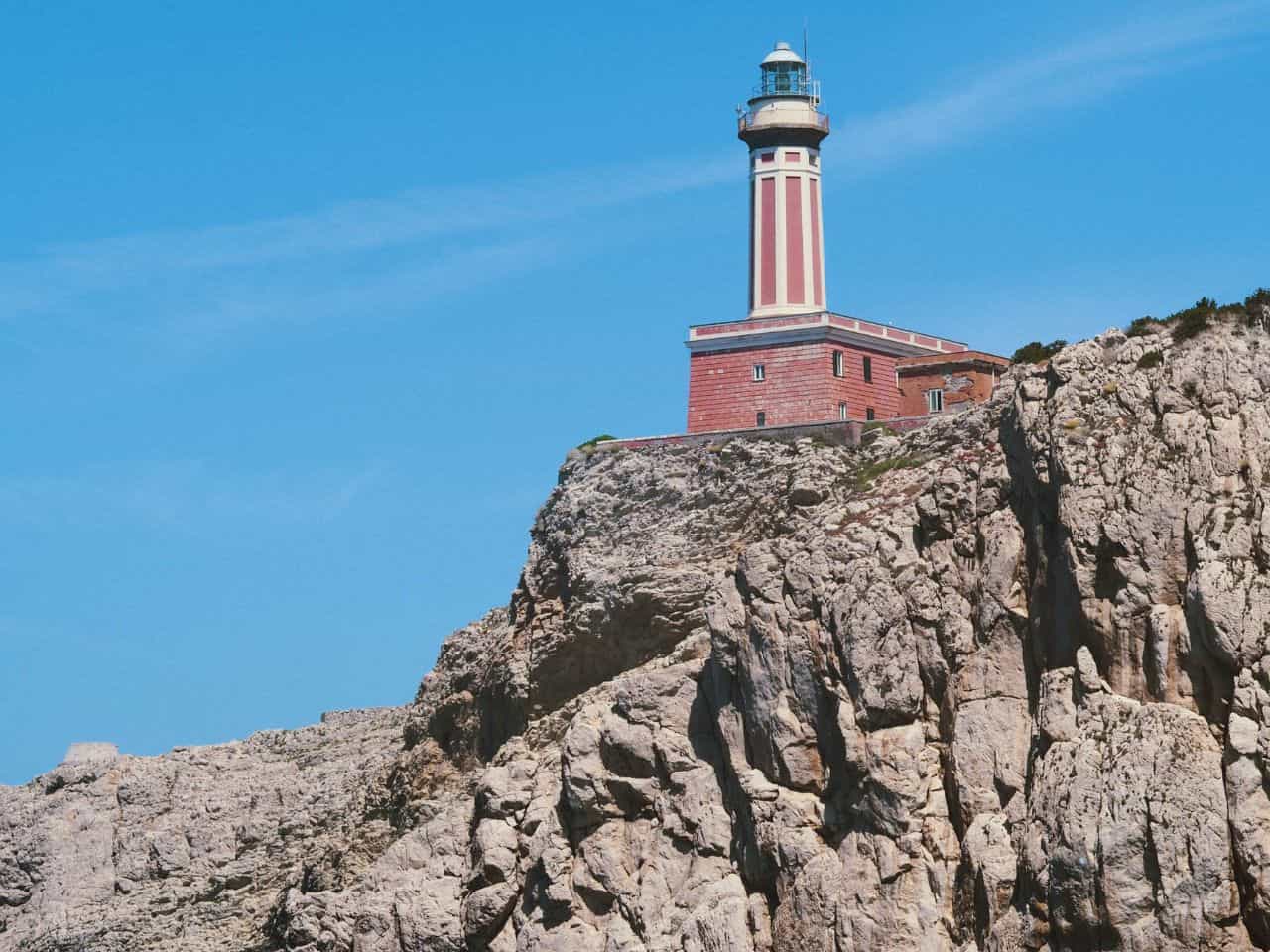
The Punta Carena Lighthouse, also known as Faro di Punta Carena, is the second most powerful lighthouse in Italy, and its beauty is as striking as its functionality. It’s a majestic lighthouse standing tall on a cliff, surrounded by the endless expanse of the Tyrrhenian Sea.
Built in 1866, its strategic location on a prominent cape made it an essential guide for mariners in the 19th century. It was designed to aid navigation for ships traveling between Naples and Sardinia for over a century, and it continues to do so even today.
The lighthouse is equipped with a Fresnel lens, which amplifies its light, making it visible from over 25 miles away.
But this spot is more than just a lighthouse—it’s a haven if you’re seeking a serene escape. Its isolated location on the southwestern tip of Capri offers a unique charm.
To reach there, you can take a local bus from Anacapri—just look for one heading toward Faro (the Italian word for lighthouse). The ride takes about 15 minutes, and once you arrive, it’s a short and scenic walk to the lighthouse. Alternatively, you can enjoy a leisurely hike from Anacapri if you’re in the mood for some exercise and great views along the way.
The area around the lighthouse is one of the few spots in Capri where you can enjoy a day by the water without the crowds. The rocky shoreline provides access to crystal-clear waters perfect for a refreshing dip.
You’ll find a small kiosk and a couple of eateries nearby serving light snacks, drinks, and delicious seafood. Imagine sipping on a glass of wine as you enjoy the tranquil surroundings,
Trust me it’s pure bliss!
Things to Keep in Mind
- Free to Visit: No tickets, no hassle—just show up and enjoy!
- Perfect for Sunset Lovers: Watching the sunset here is an experience you’ll remember forever.
14. Take a Dip in the Natural Pools
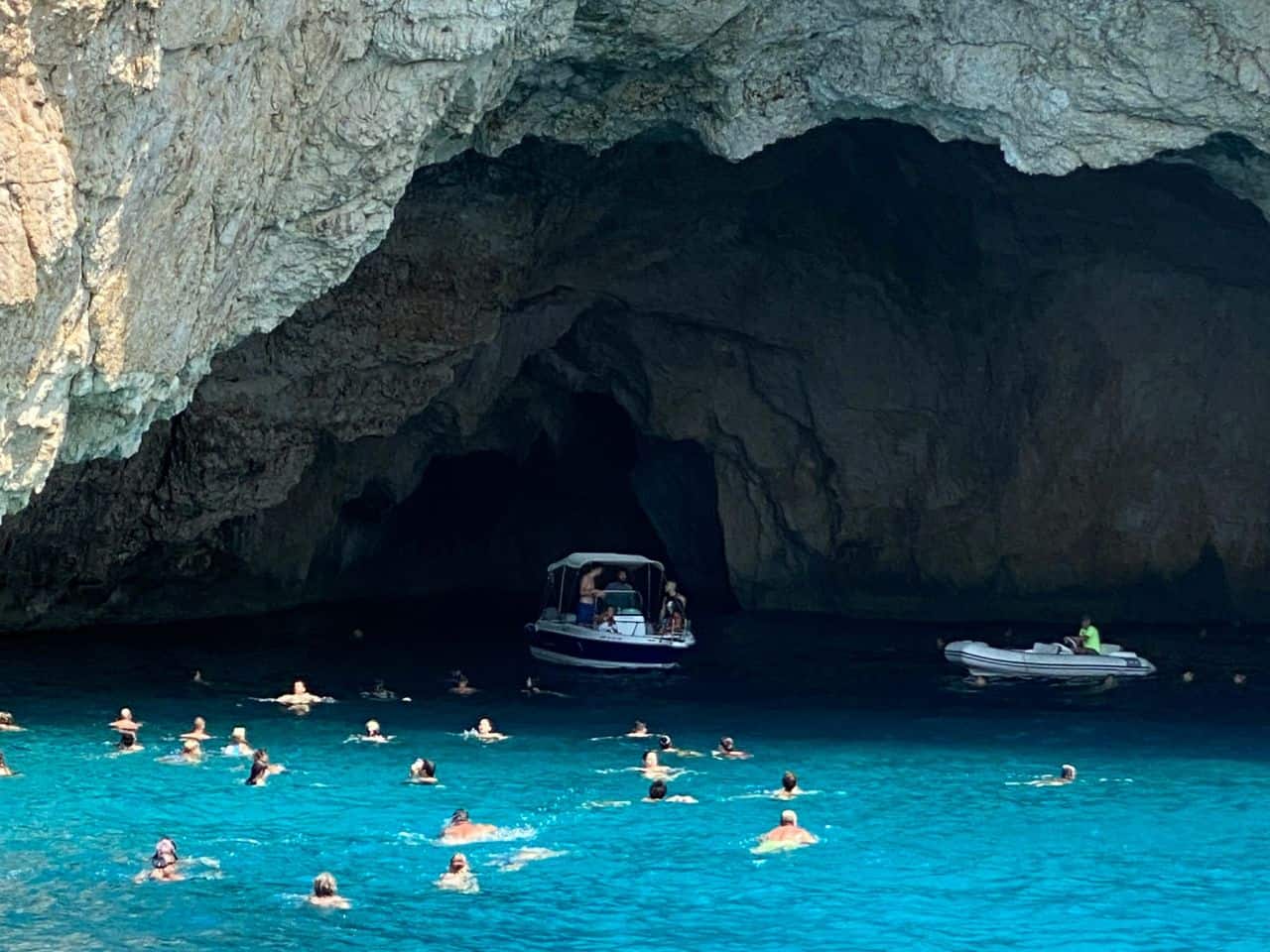
When you think of Capri, you probably picture dramatic cliffs, azure waters, and luxurious vibes. But let me confirm that this island is also home to natural pools that feel like your own private slice of heaven!
Capri’s coastline has always been shaped by volcanic activity and the relentless carving power of the sea. Over millennia, these forces created hollows and cavities in the rock, forming the natural pools you see today.
These secluded, crystal-clear pools are formed naturally carved out of the volcanic rock, creating a serene spot away from the more crowded tourist attractions along Capri’s rugged coastline, offering an intimate connection to the sea that’s unlike anything else on the island.
These pools aren’t just about swimming—they’re about immersing yourself (literally) in the raw beauty of nature. The calm waters make these pools ideal for everyone, whether you want to float, swim, or just dip your toes.
Here’s the best part—they’re absolutely free!
Bring your own towels, water shoes, and sunscreen, and you’re set for a day of relaxation.
Best Natural Pool Locations in Capri
- Punta Carena: Close to the iconic lighthouse, these pools are a favorite among locals.You can take a bus from Anacapri to Faro (Lighthouse) and then walk to the pools.
- Marina Piccola: This area offers both scenic natural pools and the option to rent sunbeds or grab a bite nearby, you can reach there by a short walk or bus ride from Capri Town.
15. Experience Traditional Cuisine

Capri’s food scene is an extension of its natural beauty—simple, fresh, and unforgettable.
Being an island, seafood has always been a staple, with recipes passed down through generations of fishermen. The use of lemons, which thrive in Capri’s unique climate, dates back centuries and has become synonymous with the island.
The dishes here are rooted in Mediterranean traditions, showcasing local ingredients like sun-ripened tomatoes, fragrant basil, freshly caught seafood, and lemons that seem to glow in the sunlight.
If you’re a food lover, tasting the local cuisine is hands down one of the best things to do in Capri. It’s all about quality over quantity, with every bite telling a story of the island’s rich culinary heritage.
You just can’t miss the iconic dishes like Insalata Caprese (Caprese Salad) Spaghetti alle Vongole, and Ravioli Capresi, paired with some Limoncello, the lemon liqueur that Capri is famous for.
End your meal with the dense Torta Caprese – chocolate-almond cake. Legend has it, it was created by mistake when a baker forgot to add flour!
My Favorite Spots (Not at all sponsored)
- Da Paolino: Known for its dreamy setting under a canopy of lemon trees, this restaurant offers a quintessential Capri dining experience.
- Aurora: Famous for its wood-fired pizzas and celebrity clientele, Aurora is where tradition meets glamour.
- La Fontelina: Nestled by the sea, this spot offers fresh seafood with a side of stunning views.
- Buonocore Gelateria: Not exactly a restaurant, but their freshly made gelato is a must-try!
Dining in Capri can range from budget-friendly meals at trattorias to luxurious feasts at high-end restaurants. A Caprese salad might set you back €10-15, while a full seafood dinner with wine could cost €40-100.
Things to Keep in Mind
- Lunch: Many restaurants open around noon, perfect for a leisurely meal before the afternoon heat.
- Dinner: Dinner service often starts around 7 PM, with locals and tourists alike enjoying long, relaxed meals.
16. Try Capri’s Lemon Specialties

The lemons grown on Capri are unique due to the island’s Mediterranean climate, fertile volcanic soil, and a long tradition of cultivation. These oversized fruits, often called sfusato amalfitano, are sweeter and less acidic than typical lemons, making them perfect for both savory dishes and decadent desserts.
From tangy desserts to refreshing beverages, trying Capri’s lemon specialties is not only a feast for your taste buds but also an immersion into the island’s rich culinary heritage.
Capri’s lemons aren’t just any citrus fruits; they’re enormous, sweet, and intensely fragrant, earning them a legendary status.
They have been a cornerstone of Capri’s agriculture for centuries, dating back to Roman times when they were prized for their medicinal and culinary uses.The practice of cultivating lemons has been passed down through generations, and many families still grow them in their private gardens.
If there’s one lemon specialty you must try, it’s limoncello, Capri’s world-famous liqueur. Served chilled, this bright yellow drink is made by steeping lemon peels in alcohol, then mixing it with water and sugar.
It’s the perfect way to end a meal, and many restaurants on the island offer their own homemade versions.
Lemon Treats You Can’t Miss
- Delizia al Limone: A mouthwatering dessert featuring sponge cake filled with lemon cream and topped with a glossy lemon glaze.
- Lemon Gelato: Refreshing and creamy, it’s the ideal treat on a warm Capri afternoon.
- Lemon Granita: A crushed ice drink bursting with citrus flavor—perfect for cooling down after exploring.
- Lemon-infused Olive Oil: Used in cooking or as a dip for fresh bread, it’s a simple yet flavorful delight.
Things to Keep in Mind
- Timings: Lemon orchards and local shops are typically open from morning to late afternoon, but restaurants serve lemon specialties throughout the day.
- Cost: Prices vary depending on what you’re sampling. A glass of limoncello costs around €5-€8, while a slice of lemon cake might be €4-€6. You can join tours of lemon orchards ranging from €20-€40, often including tastings.
17. Enjoy the Capri Wine Tour
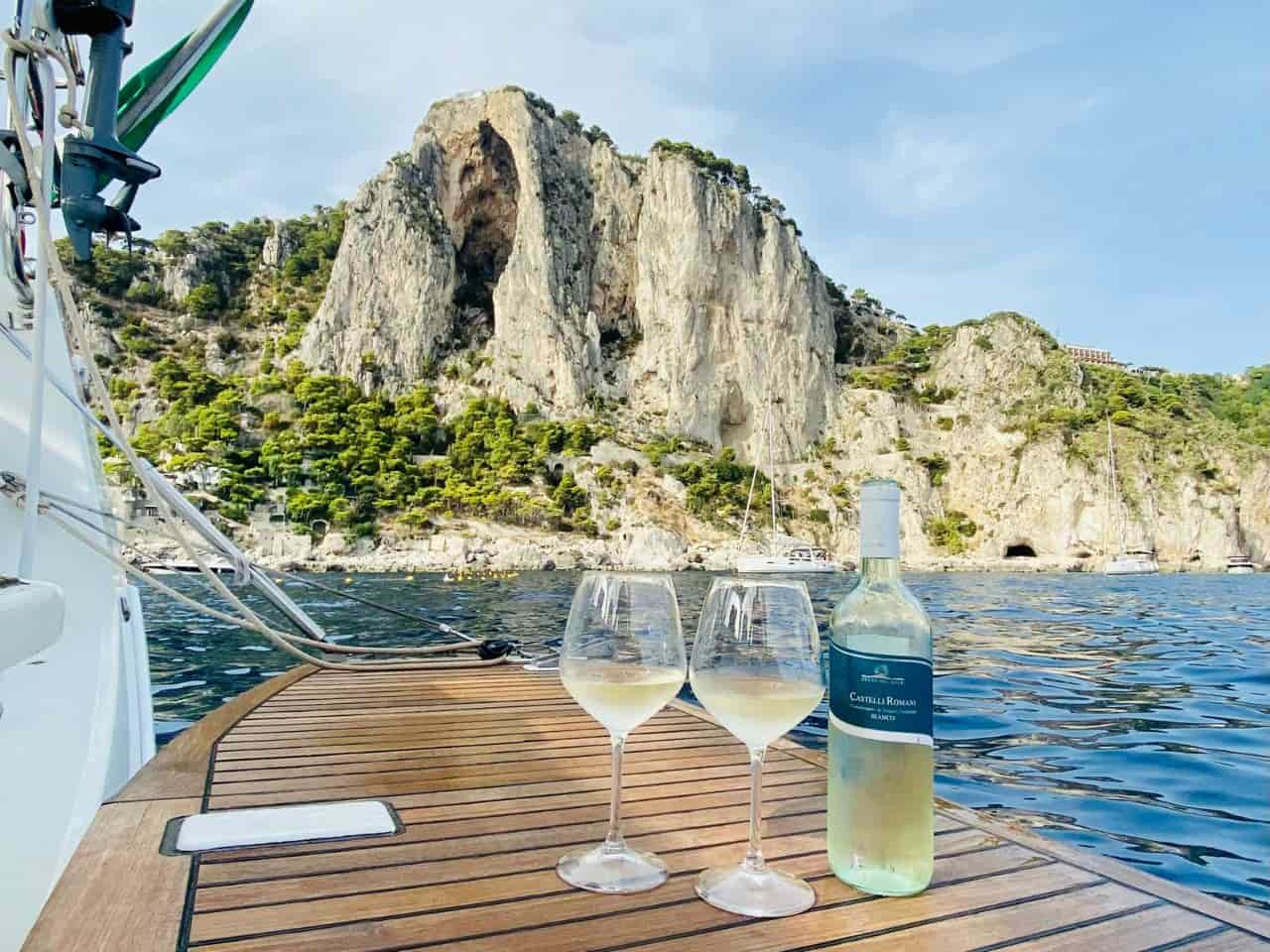
If you’re a wine lover or simply someone who enjoys indulging in the finer things in life, a Capri Wine Tour is an absolute must.
Capri’s wines are unique, shaped by the island’s volcanic soil, sunny climate, and traditional winemaking techniques. These tours usually begin with a scenic journey through the island, often by private car or even on foot for smaller group tours.
You’ll visit charming vineyards tucked away in Capri’s lesser-explored corners, rows of vines basking in the sun, winemakers passionately sharing their craft, and, of course, tasting sessions with locally produced wines.
The most iconic varieties you’ll taste include Capri Bianco, a crisp white wine, and Capri Rosso, a delicate yet full-bodied red. Pair it with local specialties like fresh cheeses, olives, and seafood, the experience becomes a feast for the senses.
Most wine tours operate during the day, usually starting around late morning (11:00 AM) and wrapping up by early evening. Exact schedules may vary depending on the tour company.
Things to Keep in Mind
- Book in Advance: Wine tours are popular, especially during peak seasons, so it’s best to reserve your spot ahead of time.
- Fees: Prices typically range from €50 to €150 per person, depending on the length of the tour, the number of tastings, and any included meals or transportation. Private tours tend to cost more but offer a personalized experience.
18. Take a Cooking Class

If you’re looking for the perfect way to take a piece of Capri back with you where no souvenir shop required! Then you can join a cooking class that lets you dive into the heart of these flavors, guided by local chefs who have mastered the art of turning simplicity into perfection.
Not only will you learn how to make traditional dishes like Caprese salad, gnocchi alla Sorrentina, or even the decadent Torta Caprese, but you’ll also get insider tips passed down through generations of Caprese families on using local ingredients and techniques that you can recreate at home.
These cooking classes in Capri often take place in charming settings like rustic kitchens, scenic terraces overlooking the sea, or even at organic farms where the ingredients are grown.
Most of them are tailored to small groups, ensuring you get personalized attention and plenty of opportunities to ask questions. They typically last between 2-4 hours and often conclude with a sit-down meal where you get to enjoy the fruits of your labor.
Things to Keep in Mind
- Book in Advance: Classes can fill up quickly, especially during peak tourist season.
- Timings: Classes are usually offered in the morning or early afternoon, so you can enjoy your meal as lunch or an early dinner.
- Fees: Prices can range from €80 to €150 per person, depending on the class and the dishes included. Some premium experiences that include wine pairings or farm tours might be slightly higher.
- Choose Wisely: Some classes focus on pasta, others on desserts or full-course meals. Pick one that matches your interests.
- Take Notes: Many chefs provide printed recipes, but jotting down tips and tricks can be helpful.
19. Hike to Arco Naturale
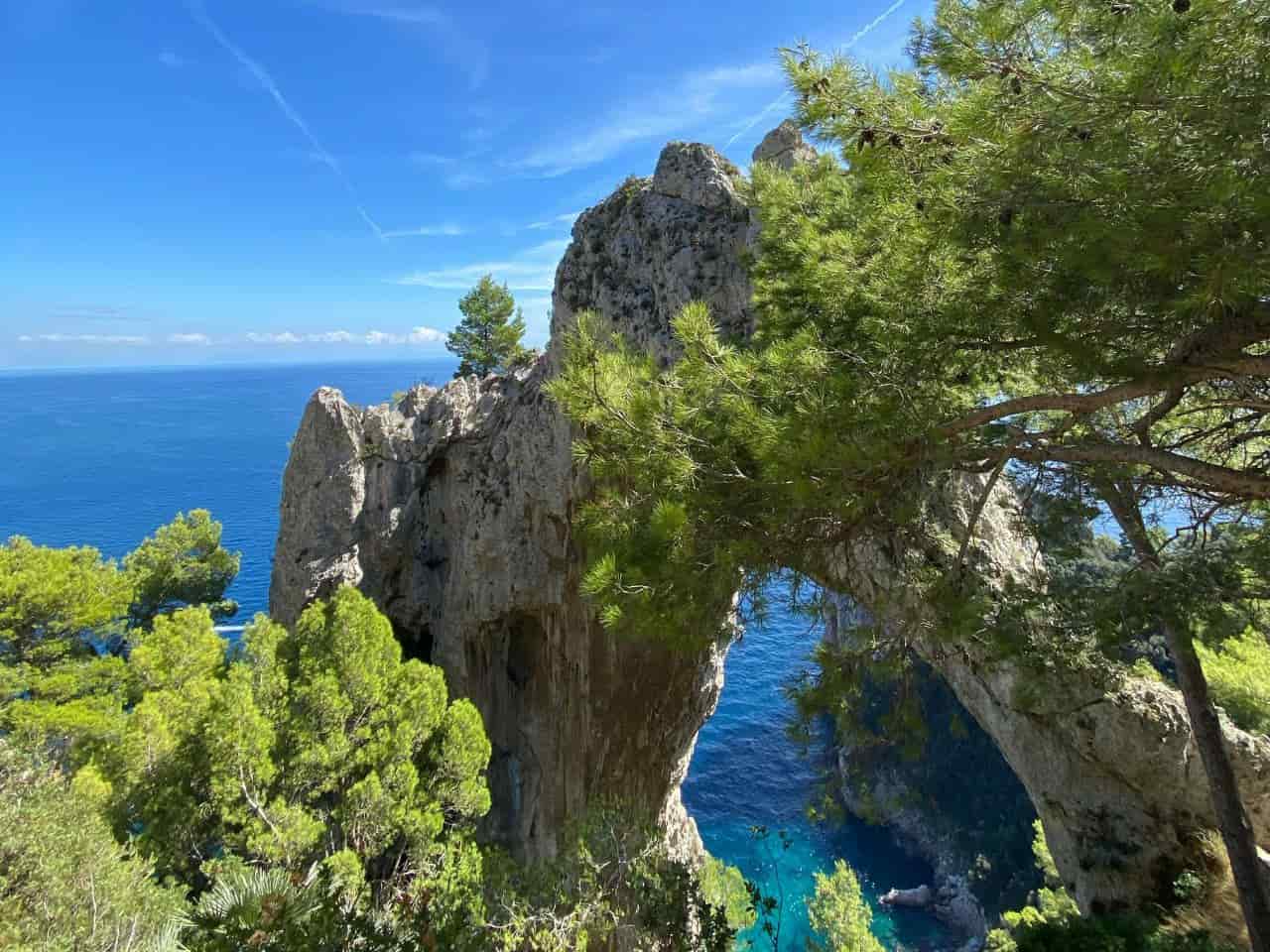
Imagine stumbling upon a natural limestone arch that looks like something sculpted by the hands of a mythical artist.
That’s Arco Naturale for you!
It dates back to prehistoric times, believed to have once been part of a sea grotto. Over thousands of years, natural forces sculpted this 18-meter-high and 12-meter-wide arch, leaving behind what we see today—a remnant of ancient Capri.
This natural arch, carved by centuries of wind and water erosion, standing tall on Capri’s eastern coastline offers a stunning view of the Mediterranean framed perfectly by the limestone.
The trail is open year-round, and it’s best to hike during daylight hours for safety and to fully enjoy the scenery.
The hike to Arco Naturale is well-marked and relatively moderate. You can begin your hike from Capri Town, near Piazzetta. Along the way, you’ll pass Villa Malaparte and picturesque viewpoints that are perfect for catching your breath and snapping some photos.
And the best part? It is completely free! to be in your list of must-do while in Capri.
Things to Keep in Mind
- Wear Comfortable Shoes: The path is uneven in some spots, so sturdy footwear is essential.
- Bring Water and Snacks: There aren’t any cafes along the way, so come prepared.
20. Relax at Bagni di Tiberio
If you’re looking to unwind, indulge in fresh seafood, or soak up your day on a historic beach club with some ancient history, this iconic spot has to be in your things to do list in Capri!
It’s a small, pebble-lined beach with crystal-clear waters perfect for swimming and snorkeling. What makes it even more appealing is the exclusive yet unpretentious atmosphere.
Situated on Capri’s northern coastline, Bagni di Tiberio is actually named after Emperor Tiberius, who ruled the Roman Empire from Capri during the first century AD. The area is said to have been one of his favorite spots, and nearby, you can still find the remnants of a Roman villa that belonged to him.
It is easily accessible by boat or on foot. A water taxi from Marina Grande takes just 5 minutes and adds a touch of adventure to your day. If you prefer walking, the path down from Capri Town is scenic but involves a bit of effort.
If you’re up for a little exploration, you can take a short stroll to view these archaeological remnants, adding a cultural twist to your day of relaxation.
The beach club here takes your relaxation up a notch. You can rent a sunbed and umbrella, sip on refreshing drinks, or enjoy freshly prepared seafood dishes at the on-site restaurant. The food is a highlight—think spaghetti alle vongole, grilled fish, and, of course, Caprese salad.
Things to Keep in Mind
- It operates seasonally, usually from April to October, and is open from around 9:00 AM to early evening.
- For a guaranteed spot during the high season, consider reserving your sunbed in advance.
- The beach club charges a fee for sunbed and umbrella rentals, usually around €20–€30 per person, depending on the season and availability.
- Meals and drinks at the restaurant are priced reasonably for Capri standards, with lunch costing roughly €20–€40 per person.
- The pebbly beach can be tough on bare feet, so water shoes are a good idea.
21. Explore the Grotta Verde
Also known as Green Grotto, it is one of Capri’s hidden treasures that feels like stepping into a natural wonderland.
Unlike the more famous Blue Grotto, the Grotta Verde offers an equally magical but more serene experience, making it a must-visit if you want to experience beauty with a touch of tranquility.
It’s believed that sailors and locals used these caves for shelter during storms and perhaps even for secret gatherings.
The best way to visit the Grotta Verde is by boat. Several companies offer guided tours around the island, often combining stops at multiple caves, including this emerald marvel.
If you’re feeling adventurous, you can even rent a kayak or paddleboard for a more intimate experience. Swimming is allowed here, so don’t forget your swimsuit—you’ll definitely want to take a dip in these dazzling waters!
Things to Keep in Mind
- Boat Tours: Most tours run between 9:00 AM and 5:00 PM, but mornings are often the best for capturing the vibrant green light.
- Costs: A standard boat tour around Capri, including the Grotta Verde, typically costs around €20-€40 per person. If you’re renting a private boat or kayak, prices may vary.
- Swimming Fees: There’s no additional cost for swimming in the grotto if you’re already on a tour.
22. Attend a Local Festival
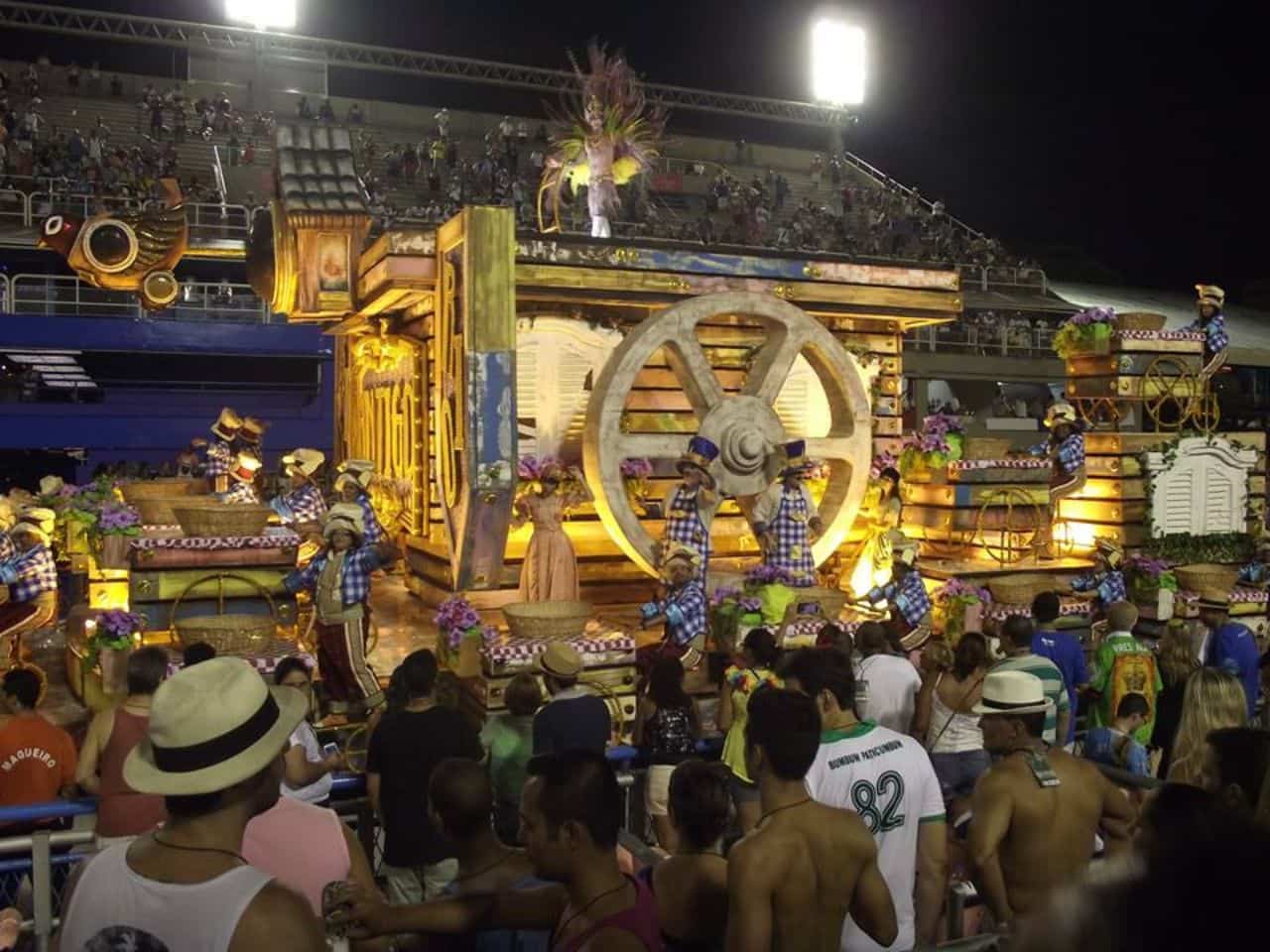
If you want to truly connect with Capri’s vibrant soul, attending a local festival is your golden ticket. Festivals on this enchanting island are a magical blend of history, culture, and lively celebrations that immerse you in its Mediterranean charm.
One of the most significant celebrations is the Feast of Saint Costanzo, Capri’s patron saint. Held every May 14th, this event honors the island’s protector with a heartfelt procession starting from Piazza Umberto I (the Piazzetta) and winding through the streets to the Church of San Costanzo.
Dating back centuries, this celebration showcases the islanders’ devotion and pride in their heritage.
Another popular event is the Settembrata Anacaprese, held in Anacapri every September. This festival celebrates the island’s agricultural traditions and local culture.
Where you can think of grape stomping, live music, folk dancing, and the aroma of freshly baked bread wafting through the air. It’s like stepping back in time to experience Capri’s simpler, rural days.
Moreover, events like Capri Hollywood, an international film festival held in December, turn the island into a hub for cinema enthusiasts. It’s a dazzling affair that attracts filmmakers, actors, and movie buffs to celebrate art amidst the island’s natural beauty.
Another standout is the Capri Tango Festival, a mesmerizing mix of music and dance. Here, the cobbled streets and open-air piazzas become stages for passionate tango performances, bringing an entirely different vibe to Capri’s enchanting nights.
Things to Keep in Mind
- Go Early: Arrive at venues early to grab a good spot for parades, performances, or tastings.
23. Explore the Ruins of Damecuta
While you’re visiting the Anacapri attractions, exploring this historic site is like stepping into a chapter of Capri’s fascinating past.
These ruins are part of Villa Damecuta, one of the 12 Roman villas believed to have been built by Emperor Tiberius during his retreat to Capri. Tiberius, who ruled Rome from 14 to 37 AD, is known for his affinity for Capri’s secluded charm.
Villa Damecuta likely served as a summer residence, offering panoramic views of the Tyrrhenian Sea and a strategic vantage point plus it won’t cost you a thing.
Although much of the villa was destroyed, likely due to fire or natural disasters, the ruins still hold a sense of grandeur. Archaeological findings suggest that it was once adorned with intricate frescoes, marble columns, and elaborate architecture that showcased the opulence of Roman life.
Things to Keep in Mind
- How to Get There: From Capri Town, take a bus or taxi to Anacapri. Once in Anacapri, it’s a short walk or bike ride to the ruins.
24. Enjoy Snorkeling and Diving
Capri’s waters are renowned for their exceptional clarity and vibrant marine life. You’ll encounter schools of colorful fish, sea urchins, starfish, and even octopuses.
Many snorkeling and diving spots are just near Capri’s iconic landmarks, like the Faraglioni Rocks where the underwater terrain, with its caves, rock formations, and coral gardens, is a paradise for marine enthusiasts.
Furthermore, the island boasts incredible locations like the Grotta Azzurra, Grotta Verde, and the underwater cliffs around Marina Piccola.
While the Grotta dei Coralli (Coral Cave) and Grotta Verde (Green Grotto) offer dramatic light effects and colorful coral that make every dive unforgettable.
These sites are teeming with marine life and offer stunning views beneath the surface. For divers, Capri’s underwater caves are a highlight.
Things to Keep in Mind
- Book in Advance: Tours and equipment can sell out, especially during peak season.
- Choose Certified Guides: If you’re diving, opt for guides certified by PADI or similar organizations for a safe experience.
- Snorkeling: Available year-round, but the best time is from May to October, when the water is warm and visibility is excellent. Renting equipment will typically cost you between €20-€40, depending on the duration.
- Diving: Most dive shops operate between April and October, with morning dives offering the best conditions. Guided dives range from €50-€150, depending on the dive site and equipment rental.
- Wear a Wetsuit: Even in summer, the Mediterranean waters can feel chilly.
25. Try Paragliding Over Capri
Whether you’re an adrenaline junkie or just looking for a once-in-a-lifetime experience, paragliding over Capri will leave you awestruck.
This will not only give you a bird’s-eye view of Capri’s most stunning attractions—the legendary Faraglioni Rocks, the lush Gardens of Augustus, and the vibrant marina below but it’s the kind of adventure you’ll talk about for years.
The paragliding flights typically begin from elevated spots on the island, such as Monte Solaro, the highest point on Capri, generally lasting between 15 to 30 minutes, depending on weather conditions and the route.
You can plan it during spring and summer, when the skies are clear, and the weather is ideal.
Make sure you go for early morning or late afternoon flights as they are known for calmer winds with golden-hour views.
And the best part?
You don’t need prior experience to enjoy paragliding here. The tandem flights with expert instructors ensure that even first-timers feel safe and confident. The equipment used is top-notch, with safety checks ensuring a worry-free flight.
Things to Keep in Mind
- Timings: These services operate during daylight hours, typically from 9:00 AM to 6:00 PM, but timings can vary depending on the provider.
- Cost: Prices range from €150 to €250 per flight, depending on the season and duration of the experience. While it’s a bit of a splurge, the memories you’ll make are priceless.
26. Watch the Sunset from Belvedere della Migliera
We have to agree on this, there’s truly something magical about sunsets, but when you’re watching one from the Belvedere della Migliera in Capri, it feels like the world itself pauses in awe.
Perched on the island’s western edge, this viewpoint is not just about spectacular views—it’s a peaceful retreat that brings you face-to-face with the unfiltered beauty of Capri’s natural landscape.
There are no fees to access the Belvedere della Migliera. Historically, this area was used for farming, with terraces carved into the hillsides.
This place offers sweeping panoramas of the Tyrrhenian Sea, rugged cliffs, and the nearby islands. As the sun dips below the horizon, the sky explodes into shades of gold, pink, and fiery red, creating a painting-like spectacle.
On clear days, you can even catch a glimpse of the distant islands of Ischia and Procida.
To reach here, you can begin your journey from Anacapri, the quieter side of the island. From Piazza Caprile, it’s a leisurely 30-40 minute walk through scenic countryside trails.
The path is well-marked and fairly easy to navigate, but comfortable walking shoes are a must. As you walk, you’ll pass rustic stone walls, vineyards, and charming old houses, adding to the charm of the experience.
If walking isn’t your thing, you can opt for a short taxi ride to Caprile and then proceed on foot for the last stretch.
Things to Keep in Mind
- Best Time to Visit: Sunset is, of course, the star of the show, so plan your visit around evening hours. The experience changes with the seasons, so in summer, sunsets are later (around 8:30 PM), while in winter, they’re earlier (around 5:00 PM).
- Stay for Twilight: Don’t rush off once the sun sets. The twilight hues and the first stars appearing in the night sky are equally captivating.
How To Reach Capri Island?
Getting here is super easy! You can hop on a ferry or hydrofoil from Naples or Sorrento, which takes anywhere from 20 to 50 minutes depending on where you start. And if you’re coming from the Amalfi Coast, no worries—there are direct connections too.
Let’s break it down one by one:
1. From Naples to Capri
- Where to catch the ferry: Ferries to Capri depart from two main ports in Naples: Molo Beverello (for high-speed hydrofoils) and Calata di Massa (for slower ferries).
- Ferry timings: The high-speed ferries from Molo Beverello generally start running around 7:00 AM and operate every 30–45 minutes throughout the day, with the last one leaving around 6:30 PM. Slower ferries from Calata di Massa have fewer departures but are more budget-friendly.
- Travel time: A high-speed ferry takes about 50 minutes, while regular ferries can take up to 80 minutes.
- Ticket cost: Prices vary from €20 to €45, depending on the type of ferry and season.
Pro Tip: Arrive at least 30 minutes early to purchase tickets and get a good seat, especially in peak summer months!
2. From Sorrento to Capri
- Where to catch the ferry: Head to the Marina Piccola port in Sorrento, which is the main hub for ferries to Capri.
- Ferry timings: Ferries start as early as 7:15 AM, with frequent departures every hour until late afternoon. The last ferry usually leaves around 6:00 PM, but it’s always wise to double-check the schedule in advance.
- Travel time: The ride is super quick—just about 20–30 minutes!
- Ticket cost: Expect to pay around €20–€30 for a one-way ticket.
Pro Tip: If you’re an early bird, hop on the first ferry for a serene ride and fewer crowds when you arrive on Capri.
3. From Amalfi Coast to Capri
- Departure points: Ferries leave from several towns along the Amalfi Coast, including Amalfi, Positano, and Salerno.
- Ferry timings: Morning departures are most common, with ferries from Positano starting at around 8:30 AM and Amalfi at around 9:00 AM. Return ferries usually wrap up by 5:30 PM.
- Travel time: Depending on your departure town, the journey can take anywhere from 50 minutes to 1 hour 30 minutes.
- Ticket cost: Prices range from €25 to €50, depending on the distance and type of ferry.
Pro Tip: Sit on the open deck if you can—it’s the best way to soak in the views of the Amalfi coastline!
4. Arriving on Capri
Once you step off the ferry, you’ll land at Marina Grande, Capri’s main port. From here, you can:
- Take a funicular: This is the quickest way to get up to Capri Town. It runs every 15 minutes, costs about €2, and takes just 5 minutes.
- Hop on a bus: Buses to both Capri Town and Anacapri are available near the port. They’re a great option if you’re heading to the island’s quieter spots.
- Grab a taxi: The iconic open-top taxis are convenient and stylish but can be pricey (€20–€30 depending on your destination).
FAQs
-
What to do in Capri for a few hours?
Start with a scenic boat tour around the island to catch the magical Blue Grotto, then stroll through the charming streets of Capri Town. Don’t miss a quick espresso at Piazzetta — it’s the island’s heartbeat! If time allows, take the funicular to the Gardens of Augustus for breathtaking views of the Faraglioni rocks before heading back.
-
Is it worth going to Capri for a day?
If you want to truly explore Capri, plan to stay at least 3 days.
But if you’re short on time, a day trip to Capri is absolutely worth it! You can hop on a boat, sail across turquoise waters, and arrive at this dreamy island surrounded by rugged cliffs — it’s a quick escape that feels like another world. -
Can you walk around Capri in a day?
You sure can — but it’ll be a busy day! Capri may be small, but its charm is endless. In one day, you can stroll through Capri Town’s chic boutiques, wander the peaceful lanes of Anacapri, and visit the Gardens of Augustus for those postcard views of the Faraglioni rocks. Just wear comfy shoes — the island’s steep lanes and stairs will definitely give you a mini workout!
Ready for these Unique Things to do in Capri?
Capri is truly beyond imagination — a slice of paradise made for every water baby out there.
I bet; this list of activities on Capri island turn out as your best travel guide to Capri and once you experience its beauty, I’m pretty sure you’ll never want to leave!
Got a question about visiting Capri? Drop it in the comments below — I’ll do my best to reply with all the details you need.
More Tips on Italy Travel
And don’t forget to check these great travel hacks for a stress-free vacation!
